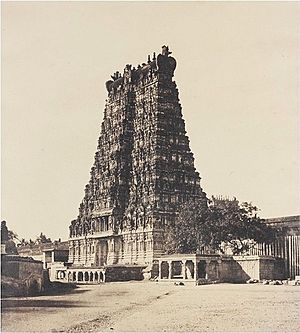Linnaeus Tripe facts for kids
Linnaeus Tripe (born April 14, 1822 – died March 2, 1902) was a British photography pioneer. He is famous for his amazing photographs of India and Burma taken in the 1850s.
Contents
Early Life and Photography Beginnings
Linnaeus Tripe was born in Plymouth Dock, Devon, England. He was one of twelve children. In 1838, he joined the East India Company army. This company was a powerful British trading company that also ruled parts of India. By 1840, he was a lieutenant in southern India.
Tripe went back to England in 1850 because he was unwell. During this time, he started trying out photography. He joined the Photographic Society of London in 1853.
He returned to India in 1854 as a captain. In December of that year, he took his first photos in India. The next year, he showed 68 photographs of temples that had never been photographed before. He won a gold medal for his pictures of Burmese buildings. Judges praised his photos for being very clear and delicate.
Exploring Burma with His Camera
After a war between Britain and Burma, a British group went to Burma in 1855. They wanted to make a peace agreement. Linnaeus Tripe was chosen to go with them. He was already known for his photography in India.
His job was to take pictures of places and buildings in Burma. This trip led to a book called Views of Burma. The Indian government asked for 50 sets of his prints. Tripe spent almost two years printing these photos. He even carefully retouched clouds and skies to make them look better. This showed his artistic skill, not just his ability to document things.
Photography in Madras
In March 1857, Tripe became the official photographer for the Madras Presidency. This was a large area in southern India ruled by the British. He took pictures of items from an exhibition and portraits of people living in Madras.
In 1858, he photographed old buildings and important engineering sites. He showed 50 of these photos in an exhibition in 1859. Some of his photos, like those of the Amaravati Stupa sculptures, are still very important today. These sculptures are now in museums in India and Britain.
After the Indian Rebellion of 1857, the British Crown took over control of India. In 1859, Tripe was told to stop taking new photos. He was later ordered to close his photography business. One of his assistants, C. Iyahswamy, also became a very good photographer.
Later Life and Retirement
In 1863, Tripe went back to the army. He was promoted many times, becoming a colonel in 1873. In 1869, he took his last two series of photographs in Burma. These were landscape pictures taken on glass negatives.
Linnaeus Tripe left India in 1873. He retired from the Army in April 1874. He passed away in Devonport, England, on March 2, 1902.
See also
- John McCosh
- Willoughby Wallace Hooper
- Felice Beato
- Philip Adolphe Klier
- Max Henry Ferrars




